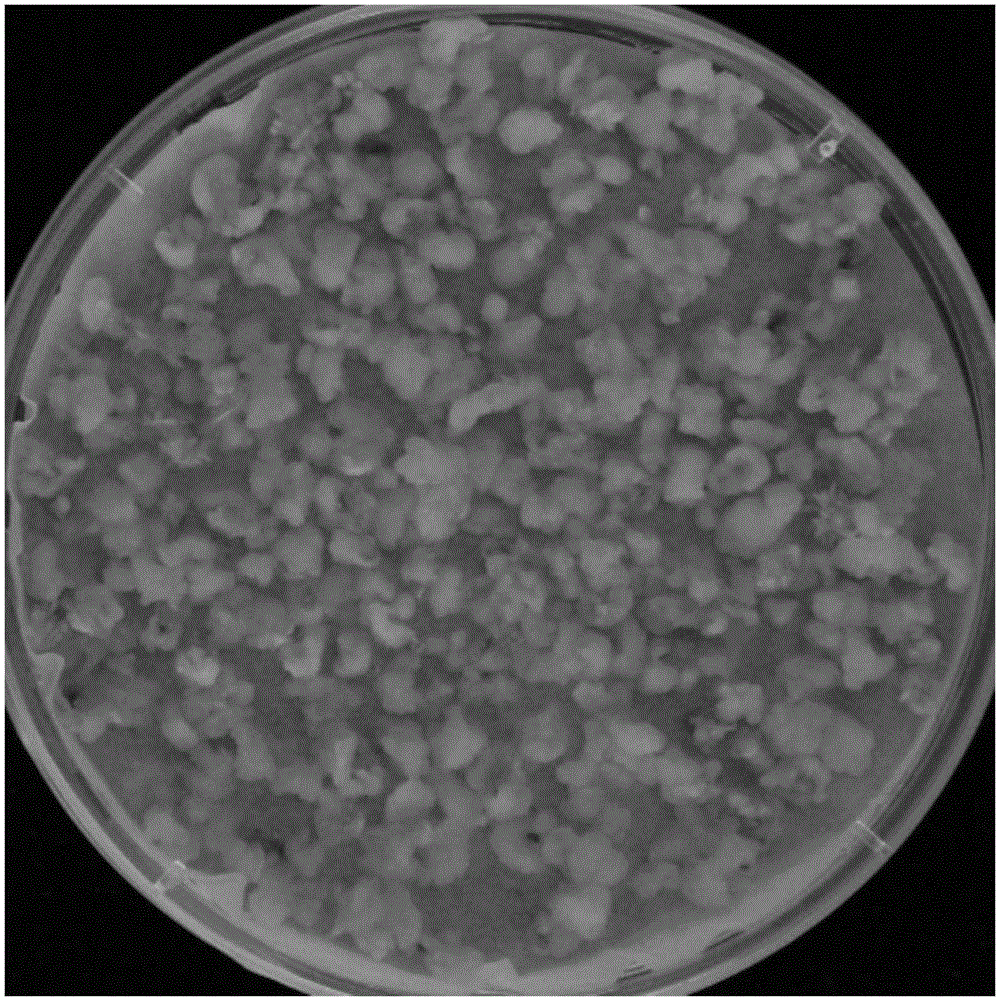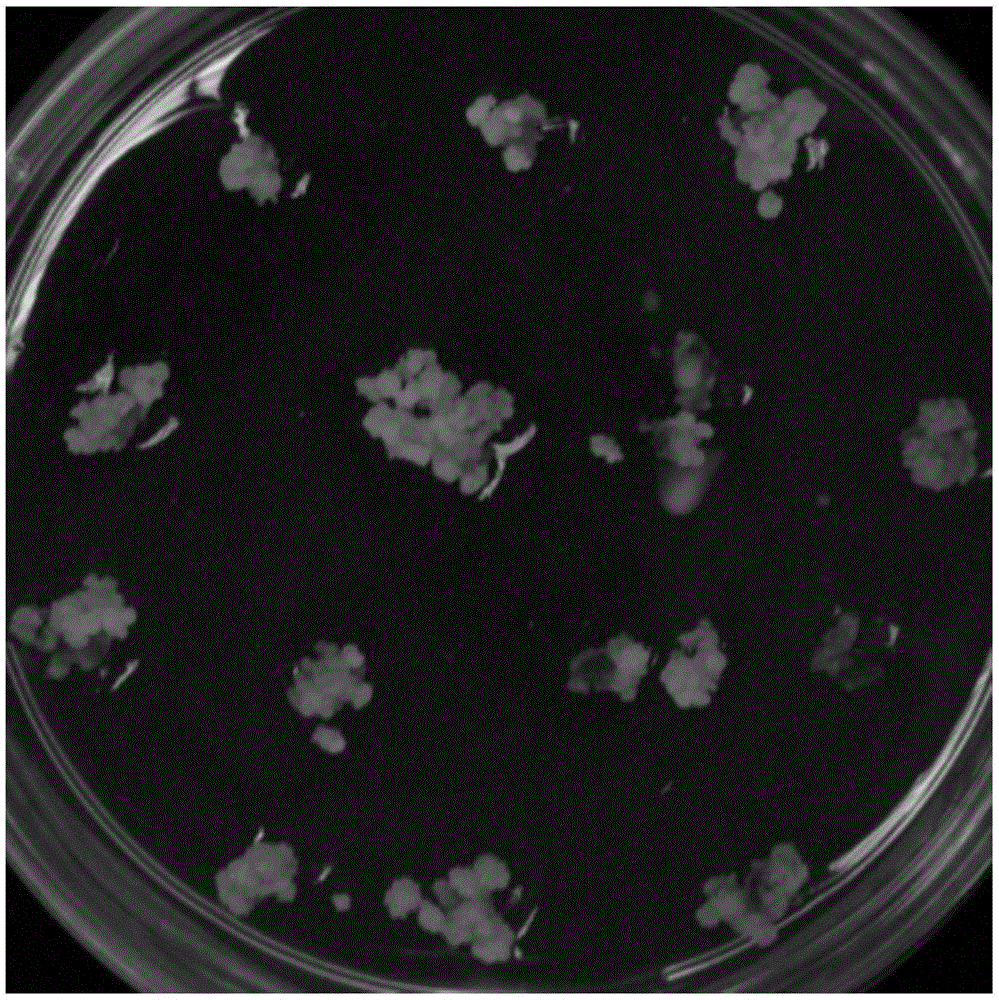Agrobacterium-mediated rapid genetic transformation method for japonica rice
A genetic transformation method, Agrobacterium-mediated technology, applied in the field of rapid genetic transformation of japonica rice mediated by Agrobacterium, can solve the problems of long genetic transformation of rice and achieve the goals of shortening the genetic transformation cycle, reducing the number of preparations, and reducing the pollution rate Effect
- Summary
- Abstract
- Description
- Claims
- Application Information
AI Technical Summary
Problems solved by technology
Method used
Image
Examples
Embodiment 1
[0058] The selection of embodiment 1 basic medium
[0059] The composition of the rice basic medium is shown in Table 1.
[0060] Table 1 Rice basal medium composition list
[0061]
[0062]
[0063] In this example, the japonica rice variety ZH11 was used as the test material.
[0064] Disinfect with sodium hypochlorite solution with an effective concentration of 2% for 15 minutes, wash with sterile water 5-6 times, and inoculate the sterilized ZH11 seeds into N 6 Y(N 6 Minimal medium+2-3mg / L2,4-D+0.3-0.6g / LCH+0.3-0.6g / LPro+30g / L sucrose+3g / LPhytagel; pH5.8) and NLY medium (NL minimal medium +2-3mg / L2,4-D+0.3-0.6g / LCH+0.3-0.6g / LPro+30g / L sucrose+3g / LPhytagel; pH5.8, NL medium composition: N 6 A lot of +N 6 Trace+L 3Organic + iron salts. ) after two weeks of induction, it was found that NL basic medium was more conducive to ZH11 callus induction, with an average induction rate of 67.77%, which was 10% higher than that of N6 basic culture (Table 2).
[0065] Table...
Embodiment 2
[0070] The setting of proline content in the induction medium of embodiment 2
[0071] Adding an appropriate amount of Pro to the induction medium can significantly increase the callus induction rate of japonica rice. It has been reported in the literature that 2.878g / L Pro is beneficial to callus induction. With NL as the basic medium, the concentration of Pro varies from 1-3g / L, and it is found that When the concentration is 1-2g / L, the average induction rate of ZH11 mature embryos is higher than 85% (Table 3), which is very conducive to callus induction, and the callus grows vigorously, and can tolerate the next step of Agrobacterium infection , it is easier to obtain resistant callus during screening culture, and the results of the later statistical analysis of the resistant callus rate are consistent with expectations.
[0072] Table 3: Effect of Pro on the induction rate of ZH11 mature embryos
[0073]
[0074]
[0075] Each of the above induction experiments is a...
Embodiment 3
[0076] Culture condition setting during the induction of embodiment 3
[0077] The induction time is preferably 9-12 days. The time is too short, the induction rate is too low, and the amount of callus is small. Usually the callus induction rate will increase rapidly after 5-6 days of mature embryo induction, and the induction rate will be 50-60% at 9 days (Table 3). After two weeks, the induction rate will basically be stable and will not increase significantly. However, in subsequent transformation experiments, it was found that the transformation effect was obviously poor when the callus induced for 14-16 days was used as the explant (data not listed), so the callus induced for 9-12 days was selected as the explant.
[0078] The co-cultivation time is controlled at 3-5 days, mainly depending on the growth status of the bacteria. The co-cultivation time of the conventional transformation experiment is 3 days, but if the activity of the bacteria is too poor, the co-cultivati...
PUM
 Login to View More
Login to View More Abstract
Description
Claims
Application Information
 Login to View More
Login to View More - R&D
- Intellectual Property
- Life Sciences
- Materials
- Tech Scout
- Unparalleled Data Quality
- Higher Quality Content
- 60% Fewer Hallucinations
Browse by: Latest US Patents, China's latest patents, Technical Efficacy Thesaurus, Application Domain, Technology Topic, Popular Technical Reports.
© 2025 PatSnap. All rights reserved.Legal|Privacy policy|Modern Slavery Act Transparency Statement|Sitemap|About US| Contact US: help@patsnap.com



